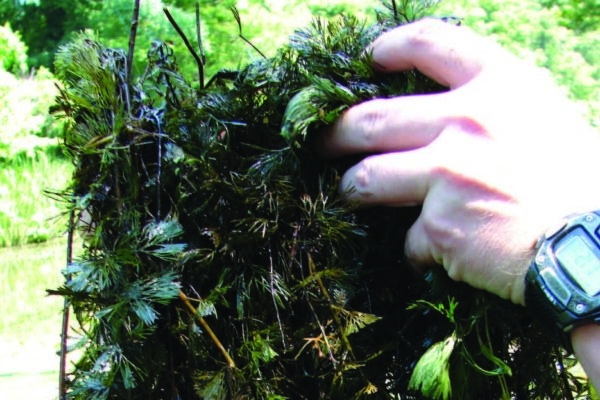Fanwort

Species at a Glance
Fanwort (Cabomba caroliniana) is a fast-growing freshwater perennial that can be found rooted or floating in waters of up to 20 feet (6 m). It is persistent, aggressive, and competitive; forming dense mats that have the potential to take over waterways.
Species Description
Fanwort can have both submerged underwater leaves and floating leaves. Underwater leaves are delicate, fan-shaped, and usually green in color, measuring 5 cm (2 in) across. They are finely divided and are arranged in opposite pairs along the stem. Floating leaves, which are not always present, are narrow, small (less than 1.3 cm [0.5 in]), oval to diamond in shape, and arranged in an alternating pattern. Flowers are small, white, pink, or purple with yellow centers and a diameter of less than 1.3 cm (0.5 in). They grow from the tips of the stems in May through September and float on the water’s surface.
Native & Introduced Ranges
Fanwort is native to South America and may also be native to some parts of the southeastern United States. It was introduced as an aquarium plant and now has invasive populations in northeastern and northwestern states. In Pennsylvania, fanwort has been reported in both the eastern and western portions of the state.
Biology & Spread
Because of its delicate appearance, fanwort is often used as an aquarium plant, and release from aquaria into the environment is considered one of the ways this plant has spread beyond its natural range. Reproduction occurs mostly as fragile stems break off and re-grow into new plants; however, they can also reproduce sexually through seed production. Both fragments and seeds can be carried by water, on boating and fishing equipment, and when people dump the contents of their aquariums into the water.
Habitat
Fanwort is a hardy plant that can survive in a wide range of aquatic habitats. It can tolerate cold waters and overwintering in the frozen lakes of northern climates, but also thrives in the warmth of southern water bodies. It is found in both low and high nutrient lakes and can tolerate varying pH levels. Although it grows best in slow moving waters, such as lakes and ponds, fanwort is occasionally found in rivers. It is most common in depths of up to 10 ft (3 m) but has been found in waters as deep as 20 ft (6 m).
Impacts
Threat to Biodiversity
Fanwort is highly persistent and competitive and is capable of rapid growth and spread. It can dominate a water body and crowd out native species, reduce biodiversity, and impact fish and other aquatic organisms that rely on native vegetation. When dense mats of fanwort decay, available oxygen in the water can quickly become depleted, resulting in low oxygen conditions that can lead to fish kills and harm other aquatic organisms.
Economic Costs
Dense stands of fanwort can clog drainage canals and freshwater systems, impacting recreational activities such as boating, fishing, and swimming, and interfering with the agricultural, and aesthetic uses of lakes and ponds.
Prevention & Control
Water drawdown methods and herbicides have been used to treat fanwort in some areas; however, prevention is cheaper and easier than treatment and therefore, early detection is important in ensuring this species does not spread to new areas. Know how to identify fanwort. Always check for and remove plants, mud, and debris from boats, trailers, clothing, and equipment before leaving a water body. Drain all water from bait buckets, bilges, and live wells before transporting to new areas. Clean all gear and equipment with hot water or salt water, OR let boats and equipment dry thoroughly for at least five days before entering a new water body.
References:
Maine Volunteer Lake Monitoring Program. 2009. Fanwort, Cabomba caroliniana. Maine’s Interactive Field Guide to Aquatic Invaders and their Native Look Alikes.
Riemer, D.N. and Ilnicki, R.D. 1968. Reproduction and Overwintering of Cabomba in New Jersey.
Weed Science. 16 (1): 101-102.
Robinson, M. 2002. Fanwort: An Invasive Aquatic Plant. DCR Massachusetts.
Washington State Department of Ecology. Non-Native Freshwater Plants. Cabomba caroliniana (Fanwort) Technical Information.



